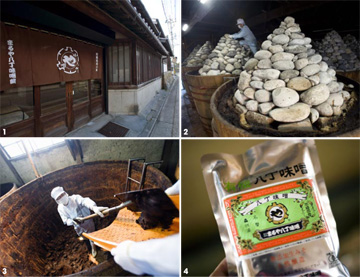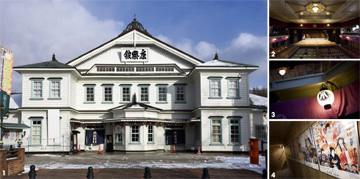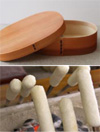Home > Highlighting JAPAN > Highlighting Japan JANUARY 2013 > Aichi/Akita
Highlighting JAPAN
[SERIES] 47 PREFECTURES: FROM A TO Y
Aichi/Akita
Aichi—Hatcho Miso
Rob Gilhooly visits a Hatcho miso maker in Aichi Prefecture.

1) Maruya Hatcho Miso, a fixture in the Hatcho region of Aichi Prefecture since 1337
2) Conical mounds of river stones are used to apply an even pressure on the miso mash.
3) Workers collect finished miso from one of Maruya Hatcho Miso’s huge cedar casks.
4) By appointment to His Imperial Majesties, high-grade Hatcho miso
Credit: ROB GILHOOLY
That fudge-like stuff is miso, a staple of the Japanese kitchen that is used in soups and sauces much like stock is employed in Western cooking. Yet, the variety being shoveled up in the Hatcho district of Okazaki City is not just any old miso.
Hatcho miso has been made in Okazaki in Aichi Prefecture’s Mikawa region for over 350 years. Since 1901, it has been supplied to Japan’s Imperial Household Agency by appointment.
There were and still are just two companies in Mikawa making it, one of which, Maruya Hatcho Miso, has been operating its brewery business since 1337, making it one of the oldest miso producers in Japan.
Company President Nobutaro Asai attributes the company’s longevity to its rigid adherence to a traditional recipe and production method that surviving records show dates back hundreds of years. This involves a simple mixture of steamed soybean mash being dusted with koji mold, which is then mixed with salt and water and left to ferment in those giant vats for two years.
“During the Second World War, the government implemented a price control system, and Maruya Hatcho Miso stopped producing miso because it was impossible to maintain quality at the controlled price,” says Asai. “That fundamental principal still remains the cornerstone of our company.”
The company’s highest grade Hatcho miso uses soy beans grown in Mikawa and spring water from a nearby mountain region whose Chinese characters mean “God Water,”—a reference to the quality for which it has been known since old times, says Asai.
After sealing the miso mash in the barrels, around 500 river stones with a combined weight of 3 tons are arranged on top in conically shaped mounds—another unique feature. The even distribution of the stones ensures consistency throughout the 6 tons of miso in each barrel. The company produces a total of 1,200 tons of miso each year—including varieties for everyday use that blend the miso with rice. Around 10 percent of its Hatcho miso is exported to twenty countries, including France and the United Kingdom.
As was traditionally the case in Japan, chefs overseas see Hatcho miso as a condiment to spice up conventional dishes, or inspire new ones. Meanwhile macrobiotics enthusiasts are taken with the health benefits of the low-salt miso, says Asai.
|
Aichi Facts Located on the Pacific Ocean side of central Japan, Aichi Prefecture is home to a thriving manufacturing industry which has long produced items such as ceramics. Today, the region is a major producer of cars, iron and steel and food products. Population: Approx. 7.41 million Area: 5,163 km2 Prefectural Capital: Nagoya City Best in Japan: Fig production, shipments of manufactured goods (for thirty-four years running)  Tokoname-yaki: With a history that dates back around a millennium, Tokoname-yaki are pieces of fired ceramics produced mainly around the city of Tokoname. Tokoname-yaki ceramics are used in a variety of products including vases, large earthenware pots, small teapots, teacups and earthen pipes. Inuyama Castle: Inuyama Castle, located in the city of Inuyama, was built beside the Kiso-gawa river in 1537. The castle’s keep, which has been designated a national treasure, is the oldest of its kind still standing in Japan.  Pumpkin Miso Honey: A dish in which akadashi (red dashi) miso made up of Hatcho miso and rice miso is combined with pumpkin and honey and simmered. 1. Cut the pumpkin (350 g) into squares three centimeters in size. 2. Place the cut pumpkin into a frying pan, add water to half fill and cook on high heat. When it comes to a boil, simmer on low heat until the pumpkin turns soft. 3. Add a mixture of akadashi miso (20 g), honey (20 g), water (100 cc) and a pinch of cumin powder to the frying pan and leave to simmer. |
Akita—Korakukan
Rob Gilhooly visits Korakukan theater in Akita Prefecture.

1) The Western-style exterior of Korakukan, Japan’s oldest extant wooden theater, in Kosaka, Akita Prefecture
2, 3) The Edo period-style interior of Korakukan theater
4) Posters advertising summer kabuki performances at Korakukan from more than twenty years ago
Credit: ROB GILHOOLY
A fate, indeed, that the building itself almost suffered. Located in Kosaka Town, Akita Prefecture, Korakukan is the oldest extant wooden theater in Japan, but one that nearly lost out to the nation’s postwar economic miracle.
“As televisions became commonplace in the sixties and movies gained wider popularity, a trip to the theater lost its appeal,” says theater manager Takemi Takahashi, adding that Korakukan was forced into a sixteen-year hiatus from 1970. “The then-owner of Korakukan saw the property as an old building that should be demolished, but kabuki actors and others who had performed here came to persuade them that it was a national treasure.”
They succeeded, although it would take another thirty years until the playhouse was recognised as an important national cultural property, a status it attained in 2007.
Korakukan opened its doors in 1910 in a town that was by then one of the most vibrant and technologically advanced of its time. The theater was built to entertain workers at the neighboring Kosaka mine, which was Japan’s leading silver producer in the late nineteenth and early twentieth centuries. Today, the Kosaka Mine Office is located across the way from the theater, the sumptuous wooden office building being another symbol of the town and having gained national heritage recognition in 2007.

Built in 1905, the magnificent Kosaka Mining Office is a symbol of the heyday of mining in Kosaka, an area which was once home to some of the country's biggest and most productive gold and silver mines. The Renaisance-style building, relocated and renovated according to original specifications in 2001, now serves mostly as a museum.
Unlike other theaters of the time, this one was lit not by candles or natural light, but electrically, courtesy of a hydro-electric power plant that was built to service the mine.
At its peak Kosaka’s population reached 35,000—six times greater than today. There were 560 water pumps dotted around town and even a social welfare system to support families when miners got injured. And at night residents would get their R&R at Korakukan—literally a “hall for healthy recreation.”
Stepping through the playhouse’s sliding wooden doors is like entering a time slip. While the building’s facade is Western in style—reflecting a fad in the Meiji period (1868–1912), when Japan enthusiastically embraced all things foreign—its interior is a throwback to Japan’s era of feudal seclusion (1603–1867). The soft tones of the cedar structure are punctuated by the pale blue ceiling—built in mock-European elegance just to accommodate an electric lighting system never before seen in many Japanese communities.
All of the gadgets that grace a traditional kabuki theater can be found—including the original 2-ton revolving stage that even today is powered by four sets of human hands.
At the rear of the stage are the gakuya dressing rooms, which are home to the playhouse’s most unique feature: graffiti. “The first kabuki actor to perform here 100 years ago wrote his name on the wall with brush and ink,” explains Takahashi. “It’s frowned upon at other theaters, but at Korakukan the tradition continues to this day.” Korakukan welcomes around 56,000 theater enthusiasts during its eight-month season.
|
Akita Facts Situated on the Sea of Japan side of the Tohoku region, Akita is known as a prefecture rich in natural beauty, with features including the Shirakami Mountain Range, which is listed as a World Heritage site, and stunning natural cedar forests. Akita Prefecture is also long said to be home to many beautiful women, giving rise to the term Akita bijin, or “Akita Beauty.” Population: Approx. 1.06 million Area: 11,636 km2 Prefectural Capital: Akita City Best in Japan: Depth of the lake Tazawa-ko (423.4 meters)  Odate Magewappa: Magewappa are a government-designated traditional craft that utilizes the uniform and beautiful grain of natural Akita cedar. Although light, magewappa crafts feature excellent strength and flexibility. They are often used as boxes for bento boxed lunches. Kiritanpo: Kiritanpo is a nabe (hot pot) dish. Kiritanpo is made by shaping pounded rice into cylinders, toasting them until light brown, and adding to chicken, maitake mushrooms and Japanese parsley to simmer. |
© 2009 Cabinet Office, Government of Japan






